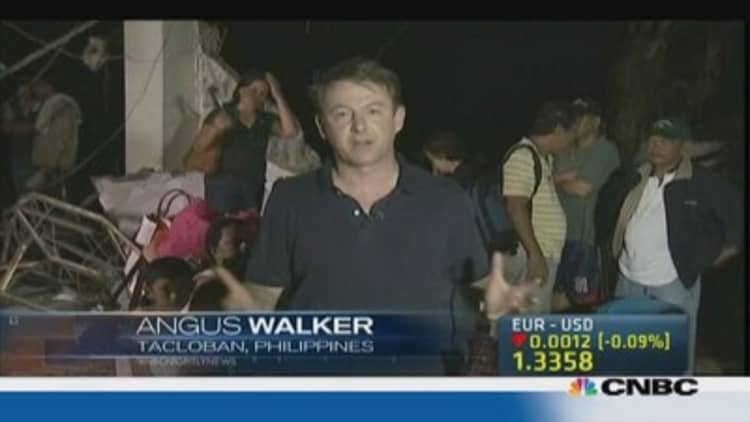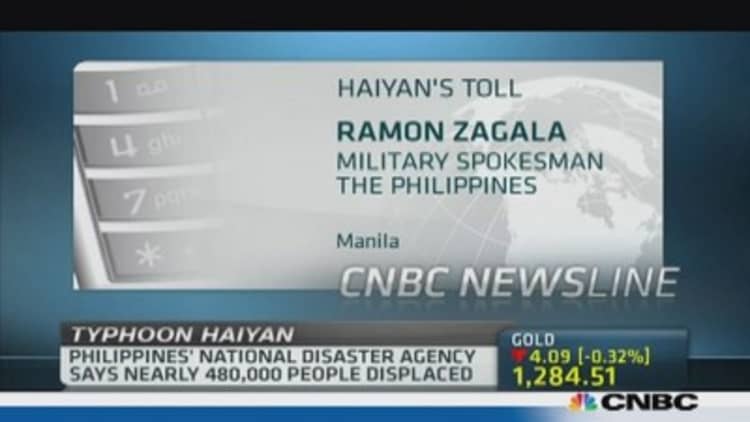
American forces were dispatched to the Philippines as the Pacific island country struggled to cope Sunday after one of the most powerful storms in recorded history killed thousands — possibly as many as 10,000 — and wreaked damage far worse than expected.
"At the request of the government of Philippines, Secretary Hagel has directed U.S. Pacific Command to support U.S. government humanitarian relief operations in the Philippines in the wake of Typhoon Haiyan," the Department of Defense said in a statement late on Saturday night.
The first wave of U.S. force — a team of 90 Marines and sailors — flew to Philippines on Sunday to assist with search and rescue operations and provide air support, the Marines said in a statement.
(Slideshow: Scenes fromPhilippines' super storm)
On Sunday afternoon, U.S. President Barack Obama released a statement saying:
"Michelle and I are deeply saddened by the loss of life and extensive damage done by Super Typhoon Yolanda. But I know the incredible resiliency of the Philippine people, and I am confident that the spirit of Bayanihan (communal work) will see you through this tragedy. The United States is already providing significant humanitarian assistance, and we stand ready to further assist the government's relief and recovery efforts. Our thoughts and prayers go out to the millions of people affected by this devastating storm."
The Marines said a team of U.S. forces from the 3rd Marine Expeditionary Brigade left for the Philippines from a U.S. base in Okinawa, Japan, aboard two KC-130J Hercules transport aircraft.
And two Florida-based Navy P-3 Orion surveillance aircraft, which had been on a six month rotation to Misawa, Japan, have been prepositioned in the Philippines to assist with search and rescue operations, the Marines said.
(Watch: Philippines Red Cross: Typhoon is 'overwhelming')
World Vision said its shipment of 5,000 blankets and 3,000 tarps would reach Cebu by Monday so that survivors could build temporary shelters in the area where up to 90 percent of the structures were destroyed.
Meanwhile, the U.N. World Food Program said they were flying 40 tons of "high energy" biscuits to the Philippines from Dubai.
The Philippines Red Cross deployed teams to distribute hot meals, blankets and medical supplies, in addition to search and rescue teams. AmeriCares also had crews on the ground providing medicine and first aid to over 20,000 people.

Haiyan's death toll could climb as high as 10,000 on the island of Leyte alone after storm surges as high as trees and wind gusts reaching 175 mph destroyed towns and villages, said chief superintendent Elmer Soria, a regional police director.
(Watch: How badly will typhoon hit Philippines peso?)
The national government and disaster agency have not confirmed the latest death toll — a notable increase from Philippine Red Cross estimates on Saturday of about 1,000 people killed.
NBC News was unable to independently confirm these numbers.
Super Typhoon Haiyan destroyed about 70 to 80 percent of structures in its path as it tore through Leyte Friday, Soria told Reuters.
An estimated 9.5 million people were affected and over 630,000 were forced from their homes and served within and outside evacuation centers, according to a Sunday report from the National Disaster Risk Reduction and Management Council (NDRRMC) of the Philippines.
(Read more: Filipino Americans across nation aid in typhoon recovery effort)
The United Nations Children's Fund estimated that 1.7 million children lived in the areas that were pummeled by Haiyan. "This is not the first natural disaster to strike the Philippines recently, following the earthquake in Bohol three weeks ago, so we know how vital it is to reach children quickly," said Tomoo Hozumi, UNICEF's representative in the Philippines.
The NDRRMC has started to compile a list of the dead by names and regions — listing electrocution, drowning and falling debris as causes of death in most cases.
"We had a meeting last night with the governor and the other officials. The governor said, based on their estimate, 10,000 died," Soria said Sunday. "The devastation is so big."
(Read more: How to help Typhoon Haiyan survivors)
The surging seas, which flattened buildings and swept away hundreds of people, resembled a tsunami, according to Reuters.
"The devastation is … I don't have words for it, it is really horrific," the country's interior minister Mar Roxas said in Tacloban, the hardest hit city. "All systems, all vestiges of modern living, communications, power, water, all are down."
Tacloban, a town of more than 220,000 people, was almost completely submerged by waves of up to 40 feet in height.
"The water was as high as a coconut tree," Sandy Torotoro, who lives near the Tacloban Airport, told The Associated Press.
Mila Ward told the AP she saw over 100 bodies on the street on her way to the airport. "They were covered with just anything — tarpaulin, roofing sheets, cardboards," she said.
(Watch: Philippines finance minister: Haiyan will hit GDP)
"From a helicopter, you can see the extent of devastation. From the shore and moving a kilometer inland, there are no structures standing. It was like a tsunami," said Roxas, who had been in Tacloban since before the typhoon struck the city.

We keep hearing about Tacloban, but "other villages may literally be wiped off the map," said NBC's Dr. Nancy Snyderman from Cebu on Sunday.
"Interestingly [some people] are trying to get in, just to see who's alive and who's not," Snyderman said earlier Sunday on TODAY. Still, many others are struggling to flee those hard-hit areas because fresh water and food are non-existent and deliveries are slow due to airport destruction and closed roads, she said.
Throughout Leyte, officials were struggling to cope with the number of dead.
"We have so many dead people," said Remedios Petilla, an official in Leyte. "We don't have bags, bags for the dead."
(Watch: Gauging the economic impact of Typhoon Haiyan)
Communications were difficult and emergency crews were slowly making their way into the hardest hit areas, but some regions were still not assessable due to closed roads and power outages, contributing to the ambiguous death toll.
"There were heavy winds, heavy rains, no power, no cell phones while the storm passed," aid worker Joe Curry of Catholic Relief Services said.
The deaths came even after officials evacuated almost 800,000 residents to emergency shelters.
"People are walking like zombies looking for food,'' Jenny Chu, a medical student in Leyte, told Reuters. "It's like a movie.''
The storm hit the coastal province of Quang Ninh at 4 a.m. Monday (4 p.m. EST on Sunday), according to the Xinhua news agency. Winds gusted at 47 mph, according to the National Center for Hydro-Meteorology.
Thousands of residents living in low-lying areas of Vietnam were evacuated to higher ground, according to the state news agency, which reported that five people had died in storm preparation efforts.
According to the Vietnam Red Cross, Haiyan is the 15th storm to hit Vietnam this year. Two September typhoons ravaged the same path that Haiyan is expected to travel, and the government may have trouble helping those affected by Haiyan since they are still aiding victims of the previous storms, the Vietnam Red Cross said in a statement Sunday.
The Weather Channel anticipated that tropical storm force winds would move quickly and affect the country for a couple of hours as the storm moved north to China, where it would dissipate.
Southern China was already experiencing heavy rain on Monday morning and six people were reported missing after their boat got lost in the South China Sea, according to Xinhua.
F. Brinley Bruton reported from London and Eric Baculinao from Tacloban. NBC News' Hasani Gittens, Reuters and The Associated Press contributed to this report.

